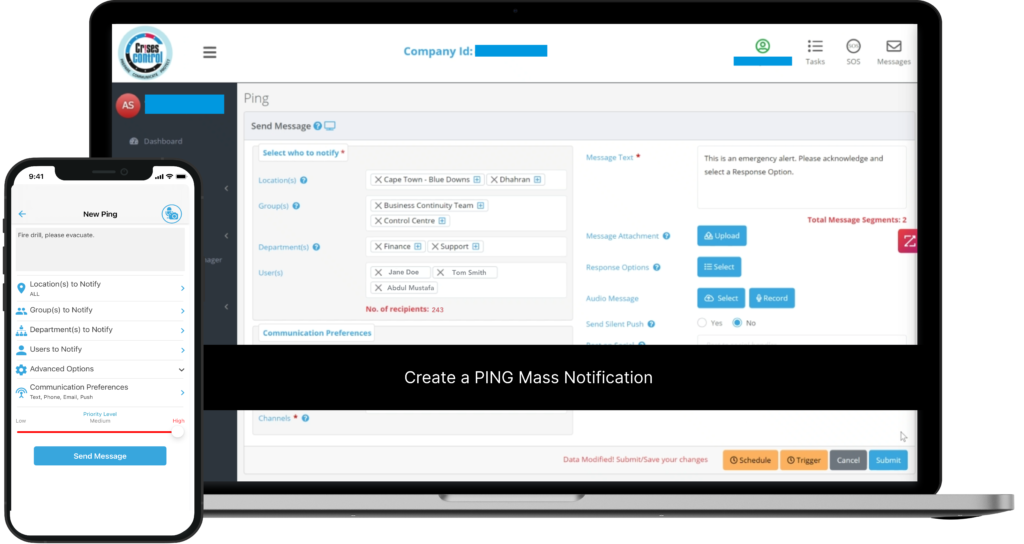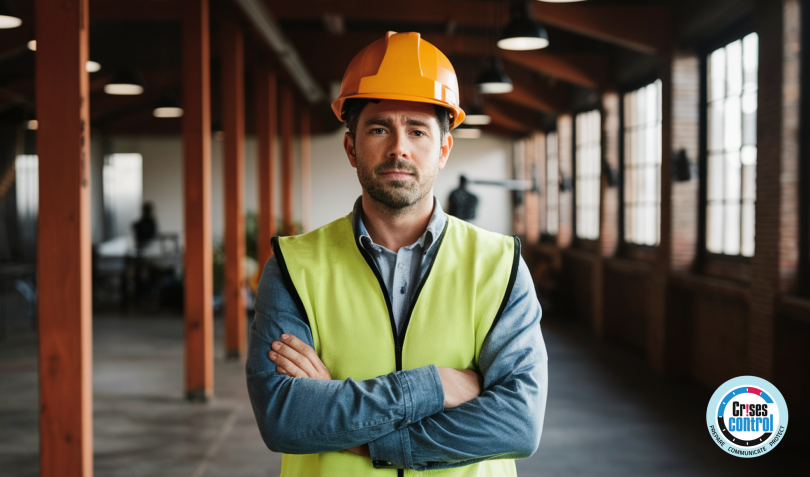Written by Anneri Fourie | Marketing Executive
Workplace safety is paramount for any organisation, regardless of size or industry. Ensuring the safety of employees and visitors is not only a legal requirement, but also a moral obligation.
In today’s fast-paced, interconnected world, the ability to respond quickly and effectively to emergencies is crucial. An emergency notification system is a vital tool that can significantly enhance workplace safety by providing real-time alerts and coordinated responses during emergencies.
Understanding Emergency Notification Systems
What is an Emergency Notification System?
An emergency notification system is a platform designed to quickly disseminate information to a large number of people in the event of an emergency. These systems utilise various communication channels such as text messages, emails, push notifications, and voice calls to ensure that critical information reaches everyone promptly.
Key Features of Effective Emergency Notification Systems
- Multi-channel Communication: The ability to send alerts via multiple channels ensures that messages are received by all intended recipients, regardless of their location or the device they are using.
- Real-time Alerts: Immediate notifications can significantly reduce response times during emergencies, potentially saving lives and minimising damage.
- Two-way Communication: Enables recipients to respond to alerts, providing valuable feedback and confirming their safety.
- Integration with Other Systems: Seamless integration with other safety and communication systems enhances overall effectiveness.
- Scalability: The system should be able to handle a large number of recipients and adapt to the growing needs of the organisation.
Importance of Real-Time Alerts
Speed and Accuracy
Real-time alerts are crucial during emergencies as they provide immediate information that can help prevent injuries and save lives. The speed at which these alerts are delivered can make a significant difference in the outcome of an emergency situation. For instance, during a fire, real-time alerts can facilitate a swift evacuation, ensuring everyone is moved to safety quickly.
Preventing Information Overload
By delivering concise and accurate information, emergency notification systems help prevent information overload, which can lead to confusion and panic. These systems ensure that only relevant information is communicated, helping recipients understand the situation and take appropriate action.
Examples of Real-Time Alerts in Action
- Natural Disasters: During events such as earthquakes, floods, or hurricanes, real-time alerts can provide crucial updates on evacuation routes, shelter locations, and safety precautions.
- Active Shooter Incidents: In the unfortunate event of an active shooter, real-time alerts can inform employees of the situation, guide them to safe areas, and keep them updated on law enforcement activities.
Coordinated Responses During Emergencies
Facilitating Coordination
Emergency notification systems play a pivotal role in facilitating coordinated responses during emergencies. By providing a central platform for communication, these systems ensure that all relevant parties are informed and can act in a unified manner.
Benefits of Coordinated Responses
- Faster Evacuations: Coordinated responses lead to quicker and more efficient evacuations, reducing the risk of injuries and fatalities.
- Better Resource Allocation: Ensures that resources such as medical assistance and emergency equipment are allocated where they are needed most.
- Enhanced Communication: Keeps all stakeholders informed, reducing the likelihood of miscommunication and ensuring a cohesive response.
Enhancing Communication and Collaboration
Internal Communication
Emergency notification systems enhance internal communication by ensuring that all employees receive timely and accurate information. This is particularly important in large organisations where employees may be spread across multiple locations or departments.
Ensuring Employee Safety
By keeping employees informed and updated, emergency notification systems help ensure their safety. Whether it’s a fire drill, a lockdown, or an actual emergency, employees need to know what’s happening and what they should do.
Collaboration with External Agencies
Emergency notification systems also facilitate collaboration with external agencies such as law enforcement, fire departments, and medical services. This ensures that these agencies are kept informed and can coordinate their efforts with the organisation’s internal response.
Integration with Other Safety Measures
Combining with Existing Protocols
To maximise effectiveness, emergency notification systems should be integrated with other safety protocols. This includes fire alarms, security systems, and evacuation plans. By combining these measures, organisations can create a comprehensive safety net that covers all potential emergencies.
Training and Drills
Regular training and drills are essential for ensuring that employees know how to respond to emergency notifications. These exercises help familiarise employees with the system and reinforce the importance of following safety protocols.
Examples of Integrated Safety Systems
- Fire Alarm Integration: Emergency notification systems can be linked to fire alarms, automatically sending alerts to all employees when a fire is detected.
- Security System Integration: Integration with security systems allows for real-time updates during security breaches or intrusions, ensuring a swift and coordinated response.
Benefits for Employers and Employees
Peace of Mind
Knowing that an emergency notification system is in place provides peace of mind for both employers and employees. Employees feel safer and more secure, while employers can be confident that they are meeting their legal and moral obligations to protect their workforce.
Legal and Regulatory Compliance
Implementing an emergency notification system helps organisations comply with legal and regulatory requirements related to workplace safety. This can prevent costly fines and legal actions, while also demonstrating a commitment to employee well-being.
Reduction in Downtime and Financial Losses
Effective emergency responses can minimise downtime and reduce financial losses during emergencies. By ensuring that employees are safe and informed, organisations can quickly resume normal operations once the emergency is over.

Interested in Mass Notification Software?
Efficiently alert everyone in seconds at scale with our Mass Notification System – PING, get the message out fast and ensure rapid response and recovery.
Implementing an Emergency Notification System
Choosing the Right System
When selecting an emergency notification system, it’s important to consider factors such as scalability, ease of use, and integration capabilities. The system should be able to grow with your organisation and adapt to changing needs.
Best Practices for Implementation
- Assess Your Needs: Understand the specific requirements of your organisation and choose a system that meets those needs.
- Training: Ensure that all employees are trained on how to use the system and understand its importance.
- Regular Testing: Conduct regular tests to ensure that the system is functioning correctly and that employees know how to respond to alerts.
- Continuous Improvement: Regularly review and update your emergency notification procedures to incorporate new best practices and technologies.
Conclusion
Emergency notification systems play a crucial role in ensuring workplace safety by providing real-time alerts and facilitating coordinated responses during emergencies. These systems enhance communication, improve collaboration, and integrate seamlessly with other safety measures to create a comprehensive safety net for your organisation.
At Crises Control, we understand the importance of effective emergency notification systems. Our platform offers a robust, scalable solution that ensures your organisation is prepared for any emergency. Contact us today to get a free personalised demo and see how Crises Control can enhance the safety and security of your workplace.
Request a FREE Demo








